When measuring lye for soap making, always wear protective gear including chemical-resistant gloves, safety goggles, and long sleeves. Use a digital scale that measures to 0.1g precision and calibrate it regularly. Create a designated workspace with proper ventilation. Always add lye to water, never the reverse. Control temperature during dissolution to prevent dangerous reactions. Store lye in clearly labeled, sealed containers away from children. These safety practices will transform your soap making into a hazard-free craft.
7 Essential Tips for Measuring Lye Without Risk
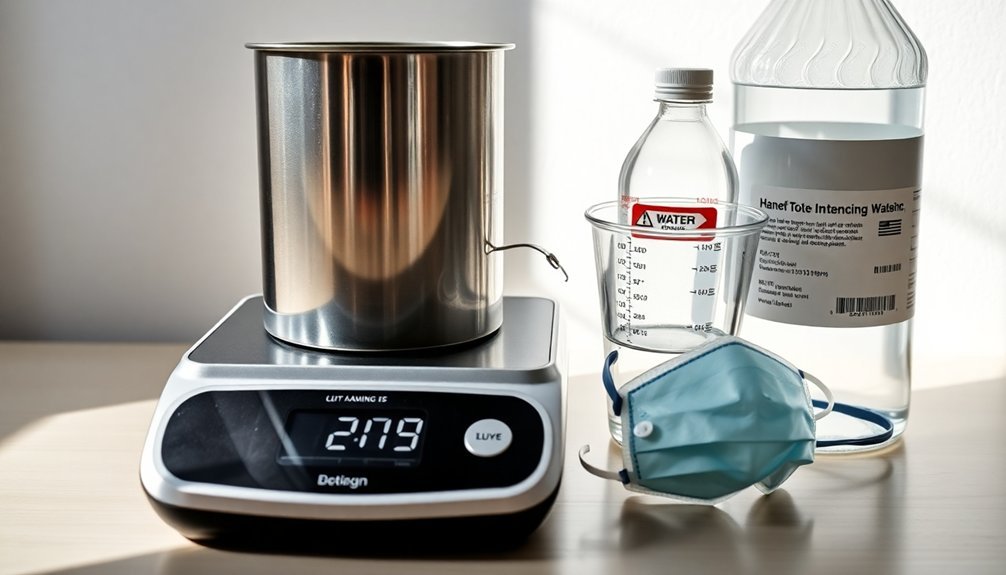
When working with lye, safety must always be your top priority. Invest in a digital scale for precise measurements, as inaccuracies can compromise your soap's safety and quality.
Never handle lye without proper protective gear—gloves, goggles, and a mask are non-negotiable safety precautions to prevent burns and respiratory issues. Always work in a well-ventilated area or outdoors to avoid inhaling harmful fumes that lye releases.
Select measuring containers made of glass or heat-resistant plastic—never aluminum, which reacts dangerously with lye.
Remember the cardinal rule: add lye to water (never the reverse), stirring continuously to prevent dangerous eruptions. This guarantees the lye dissolves completely before you incorporate it into your soap recipe.
Proper Protection Gear for Handling Sodium Hydroxide
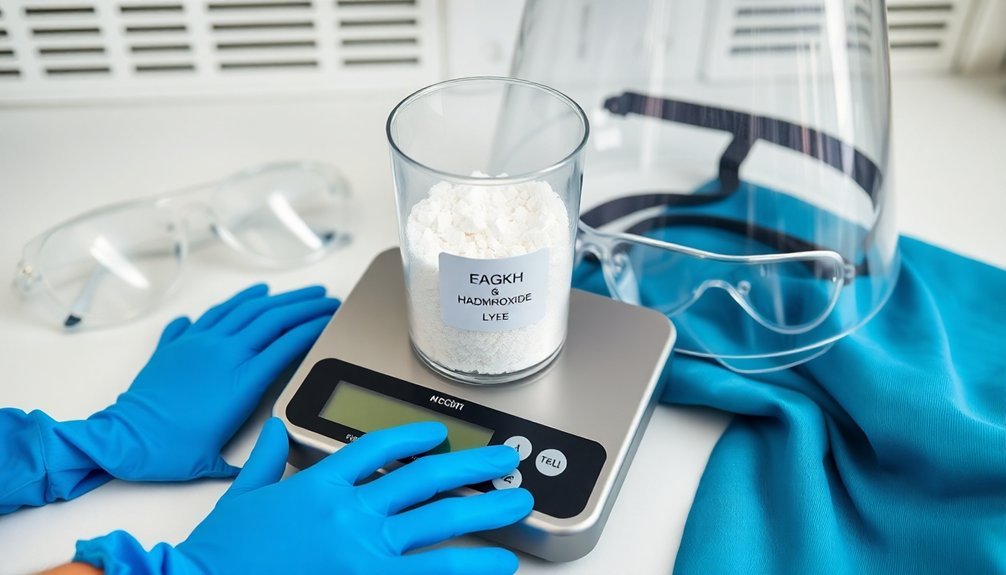
When handling sodium hydroxide for soapmaking, you'll need proper protective gear that includes chemical-resistant gloves, secure-fitting safety goggles, and appropriate clothing coverage.
Select thick rubber or nitrile gloves that extend up your forearms, not thin disposable versions that can deteriorate upon contact with lye.
Your eyes require special attention with wraparound safety goggles that prevent splashes from entering from any angle.
Protective Gear Essentials
Four essential items form your basic safety armor when handling sodium hydroxide (lye).
You'll need chemical-resistant rubber gloves that extend well up your arms to protect your skin from potential burns. Always wear safety goggles that seal completely around your eyes—lye can cause blindness if splashed into your eyes. Protective clothing with long sleeves and pants creates a barrier between your skin and any accidental splashes.
- Wear thick rubber gloves that are specifically designed to resist caustic substances
- Use safety goggles that fit snugly to prevent any side splashes
- Don a properly fitted respirator to avoid inhaling harmful fumes
- Choose closed-toe shoes to protect your feet from spills
Never compromise on these safety measures—your health depends on proper protection.
Glove Selection Guide
Selecting the right gloves stands as your first line of defense against lye's caustic nature. When handling sodium hydroxide, choose thick rubber or nitrile gloves specifically designed for chemical handling—never regular latex medical gloves, which offer inadequate protection against lye exposure.
Your protective gloves should be long enough to tuck under sleeves, preventing splashes from reaching your skin during the soapmaking process. Before each use, inspect them carefully for tears, holes, or signs of wear that might compromise their protective ability.
Don't remove your gloves until you've completed not only the mixing but also the cleanup phase. This thorough glove selection guide guarantees you'll protect your hands throughout the entire process, minimizing any risk of painful chemical burns.
Eye Protection Matters
The protection of your eyes deserves unwavering attention when working with sodium hydroxide. Regular glasses won't shield you from dangerous chemical splashes—always use safety goggles specifically designed for handling lye.
Choose eye protection that creates a complete seal around your eyes to prevent potentially blinding lye exposure.
- Confirm your safety goggles fit securely with no gaps where particles could enter
- Inspect your protective gear regularly for damage and replace when necessary
- Position an eyewash station or running water source nearby for immediate rinsing
- Select face shields or goggles certified for chemical splash protection, not standard eyewear
Selecting the Right Scale for Precise Measurements
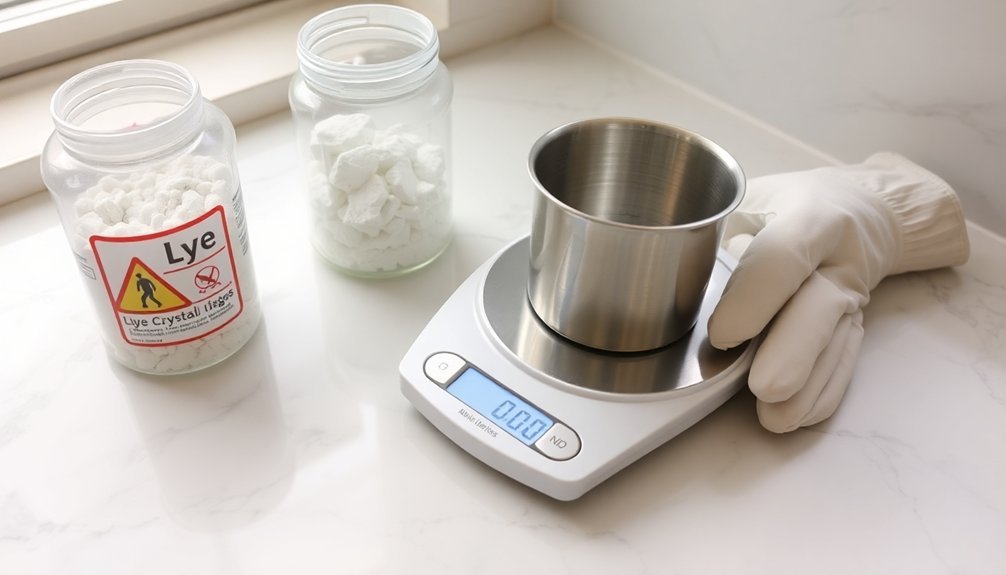
When measuring lye for soap making, you'll need a digital scale that displays weight in grams, as analog scales simply don't provide the precision required for safe formulations.
Your scale must be properly calibrated before each use—a quick zero-check with a known weight guarantees your measurements won't lead to lye-heavy (harsh) or oil-heavy (soft) soap.
Always confirm your scale can accurately register tiny amounts (0.1g precision or better), especially when working with small batches where even slight measurement errors can greatly impact your final product.
Digital vs. Analog Scales
Because precision matters greatly in soap making, your choice between digital and analog scales can profoundly impact your results.
Digital scales offer measurements to the nearest gram, ensuring you're adding exactly the right amount of lye for proper saponification. When measuring lye, even small inaccuracies can lead to soap that's either too caustic or fails to harden properly.
- Digital scales with tare function allow you to zero out container weight for true lye measurements
- Look for scales with capacity of at least 5 kg (11 lbs) to handle typical soap batches
- Analog scales introduce potential measurement errors that can compromise your soap's quality
- Following safety guidelines includes using appropriate equipment—digital scales are part of that equation
Calibration Matters Most
Precise lye measurements begin with proper scale calibration, which serves as the foundation for safe and successful soap making. Before weighing any ingredients, take a moment to calibrate your scale according to the manufacturer's instructions. This simple step guarantees your measurements remain accurate and consistent throughout your soapmaking process.
Your scale should be calibrated each time you use it, as even minor inaccuracies can lead to excess lye in your final soap. After calibrating, verify accuracy by weighing a known object.
Remember that a properly functioning scale should measure in grams and handle at least 500 grams to accommodate both lye and water for standard batches.
If your scale has been dropped or exposed to moisture, check for drift before trusting its readings. Reliable calibration is your first defense against potentially unsafe soap.
Accuracy Within Grams
Selecting a digital scale that measures to the nearest 0.1 gram stands as your most critical investment for safe soapmaking. When you're measuring lye, even small variations can greatly impact your soap's quality and safety. Your scale should include a tare function to zero out container weight, guaranteeing you're only measuring the lye itself.
- Choose a scale with at least 5 kg capacity to accommodate various batch sizes.
- Look for a stable platform that won't wobble during precise calculations.
- Verify the display is easy to read to avoid dangerous measuring errors.
- Regularly calibrate your scale to maintain accuracy over time.
Don't compromise on accuracy when working with caustic substances. A reliable digital scale isn't just a tool—it's your primary safeguard against miscalculations that could render your soap unusable or potentially harmful.
Creating a Designated Lye Workspace
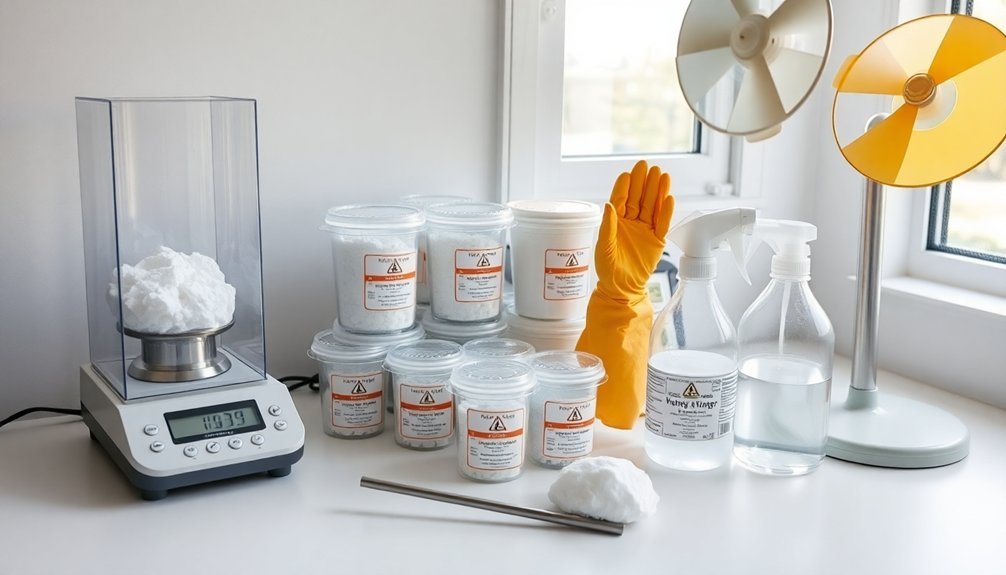
When working with lye, safety must be your top priority. Establish a specific area in your workspace dedicated solely to lye preparation. This separation prevents contamination and keeps your lye-related materials organized.
Choose a non-reactive surface like stainless steel or a dedicated plastic mat for your designated workspace. This prevents damage and simplifies cleanup.
Always keep essential safety gear—gloves, goggles, and masks—within easy reach to guarantee you'll use them consistently.
Ascertain your area is well-ventilated with fans or open windows to disperse potentially harmful fumes.
Clearly label the container for any lye solution you prepare and store unused lye in a marked cabinet that's locked and inaccessible to children and pets.
The Correct Order: Always Add Lye to Water
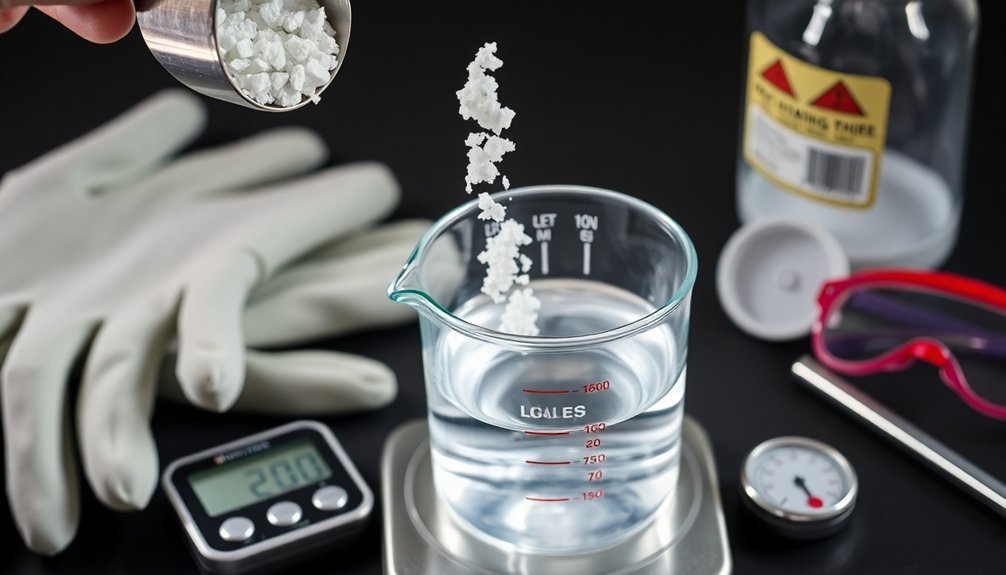
One of the most critical safety rules in soap making is remembering the correct mixing order: lye goes into water, never water into lye. This mantra exists for your safety during the soap making process.
When you add lye to water, it creates an exothermic reaction, generating significant heat. Reversing this order can cause dangerous eruptions as the concentrated solution overheats and potentially splashes.
- Pour lye gradually into water while stirring continuously to prevent clumping
- Use heat-resistant containers like glass or certain plastics that won't break when temperatures rise
- Work in well-ventilated areas to avoid inhaling lye fumes
- Measure ingredients precisely with a scale to guarantee proper chemical reactions
Always prioritize safety when handling lye—it's the foundation of successful soap making.
Mastering Temperature Control During Dissolution
The proper control of temperature remains essential while dissolving lye in water, as the exothermic reaction can quickly push temperatures above 200°F. Always use heat-resistant containers to prevent damage from this intense heat.
For better temperature control, start with cold distilled water before adding lye to the water. Stir continuously while pouring the lye slowly to encourage even dissolution and prevent dangerous hot spots that might cause splashing. Keep a thermometer handy to monitor the solution's temperature throughout the process.
Always work in a well-ventilated area to avoid inhaling the caustic fumes released during the reaction.
When mixing lye solution, patience is key—rushing increases risk. Allow adequate time for the solution to cool before proceeding with your project.
Safe Storage and Labeling of Lye Containers
Proper handling of lye extends beyond the mixing process to how you'll store this powerful chemical. Always keep lye containers in a locked cabinet to prevent unauthorized access by children and pets.
Choose rigid, clearly labeled containers that seal tightly to avoid accidental spills and contamination.
- Post first aid procedures near your lye storage area for immediate reference during emergencies
- Inspect containers regularly for signs of wear or leakage, replacing them promptly
- Store away from moisture and other chemicals to prevent dangerous reactions
- Use permanent labels that clearly identify contents, concentration, and potential hazards
Your safe storage practices are just as important as your measuring techniques.
Frequently Asked Questions
How to Work With Lye Safely?
To work with lye safely, always wear protective gear, mix in ventilated areas, use proper containers, add lye to water (never reverse), and keep first aid supplies nearby for emergencies. You'll avoid dangerous exposure.
Which of the Following Should Not Be Done When Working With Lye?
You shouldn't add water to lye, use aluminum containers, mix in enclosed spaces without ventilation, skip protective gear, or allow yourself to be distracted when working with lye. Each mistake can cause serious safety hazards.
How to Calculate Lye?
To calculate lye, you'll need to use a soap calculator. Input your oils and their amounts, select your desired superfat percentage, and the calculator will determine the exact lye weight needed for safe saponification.
What Not to Do With Lye?
Don't add water to lye, use aluminum containers, mix in poorly ventilated areas, neutralize with acids, or skip PPE. You'll risk violent reactions, flammable gas, respiratory harm, dangerous chemical reactions, and serious burns.
In Summary
You've now mastered the essential safety protocols for lye handling. Remember, there's no room for shortcuts when working with sodium hydroxide. Always wear your protective gear, use precise measurements, maintain your dedicated workspace, and follow the correct mixing order. By respecting lye's caustic nature and implementing these preventative measures, you'll enjoy soap making with confidence and peace of mind.

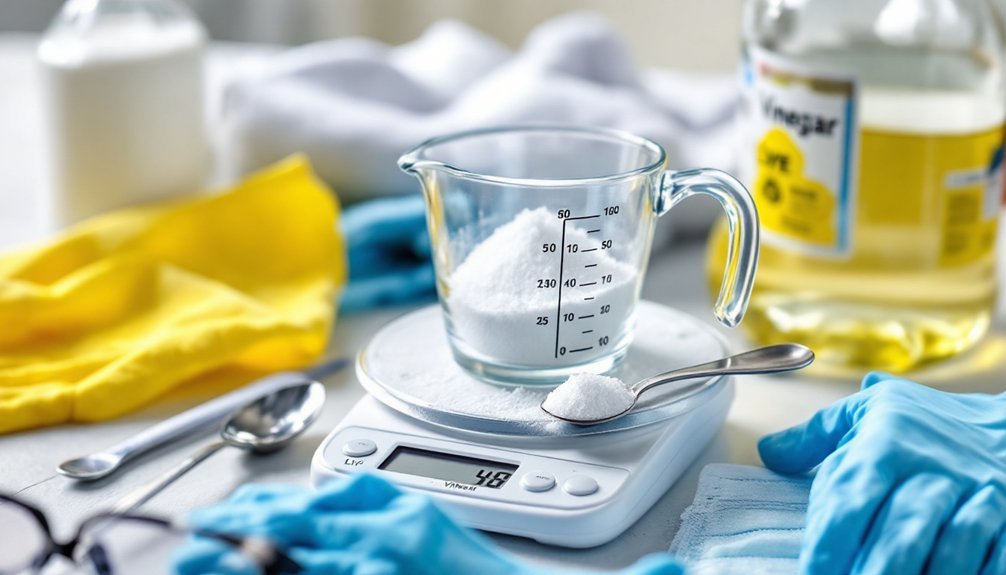



Leave a Reply